Hardware Migration
Introduction
In this article you will learn the recommended options for migrating from Tegra-based modules.
Select a Replacement Product
We recommend replacement options within the same product family of the currently used SoM, or migration to the Verdin Family. In either case, you will have modern and cost-effective options.
You can use the Toradex Product Comparison feature to compare the product you are currently using to different SoMs in order to evaluate their features. Check the table and the links for quick comparisons.
Colibri T20
| Replacement Option | Product Comparison | Pros | Cons |
|---|---|---|---|
| Colibri iMX6 | Compare to Colibri T20 512MB /512MB IT Compare to Colibri T20 256MB /256MB IT | - In most cases, no carrier board redesign is required - WEC is available, so porting from WEC is easy - Cost-effective | - Lower performance |
| Colibri iMX8X | Compare to Colibri T20 512MB /512MB IT Compare to Colibri T20 256MB /256MB IT | - In most cases, no carrier board redesign is required - Performance Boost - Longevity commitment until 2035+ - Modern future-proof SW stack | - Move from WEC to Linux / Torizon |
| Verdin Family | Compare to Colibri T20 512MB /512MB IT Compare to Colibri T20 256MB /256MB IT | - Large Scalability in price and performance - Future-proof design - Modern future-proof SW stack | - Carrier Board redesign is required - Move from WEC to Linux / Torizon |
Colibri T30
| Replacement Option | Product Comparison | Pros | Cons |
|---|---|---|---|
| Colibri iMX6 | Compare to Colibri T30 1GB /1GB IT | - In most cases, no carrier board redesign is required - WEC is available, so porting from WEC is easy - Cost-effective | - Significantly Lower performance |
| Colibri iMX8X | Compare to Colibri T30 1GB /1GB IT | - In most cases, no carrier board redesign is required - Performance Boost - Longevity commitment until 2035+ - Modern future-proof SW stack | - Move from WEC to Linux / Torizon |
| Verdin Family | Compare to Colibri T30 1GB /1GB IT | - Large Scalability in price and performance - Future-proof design - Modern future-proof SW stack | - Carrier Board redesign is required - Move from WEC to Linux / Torizon |
Apalis T30
| Replacement Option | Product Comparison | Pros | Cons |
|---|---|---|---|
| Apalis iMX6 | Compare to Apalis T30 1GB/ 1GB IT Compare to Apalis T30 2GB | - In most cases, no carrier board redesign is required - WEC is available, so porting from WEC is easy - Cost-effective | - Lower performance |
| Apalis iMX8 | Compare to Apalis T30 1GB/ 1GB IT Compare to Apalis T30 2GB | - In most cases, no carrier board redesign is required - Performance Boost - Longevity commitment until 2035+ - Modern future-proof SW stack | - Move from WEC to Linux / Torizon |
| Verdin Family | Compare to Apalis T30 1GB/ 1GB IT Compare to Apalis T30 2GB | - Large Scalability in price and performance - Future-proof design - Modern future-proof SW stack | - Carrier Board redesign is required - Move from WEC to Linux / Torizon |
Performance Comparison
Disclaimer
The goal of these measurements is to benchmark and compare SoM's from the Colibri Family: T20, T30, iMX6 and iMX8X.
Please keep in mind that no tool can give a definitive result about which system is better, as each application demands specific resources at different levels. Testing your application on different systems is the best way to know actual performance.
Software Used
- Colibri T20 and T30: Toradex Reference Multimedia Image BSP 2.8 LXDE – Kernel 3.1 downstream from Nvidia
- Colibri iMX6 and Colibri iMX8X: Toradex Reference Multimedia Image BSP 5.7.2 – Kernel 5.4 downstream from NXP
Hardware Used
-
Carrier Board:
- Colibri Evaluation Board v3.2B
-
SoM:
- Colibri T20 512 MB v1.2A
- Colibri T30 1GB V1.1F
- Colibri iMX6DL 512MB v1.1B
- Colibri IMX8DX 1GB WB v1.0D
- Colibri IMX8QXP 2GB WB IT v1.0D
Processor Performance - Coremark
This benchmark gives an idea of what the performance of the processor is for standard CPU-bound activities without frequent need for memory operations.
Use cases:
- CPU workload for GUI applications
- State management and integer calculations that are done as part of the application
- Some Kernel functionality
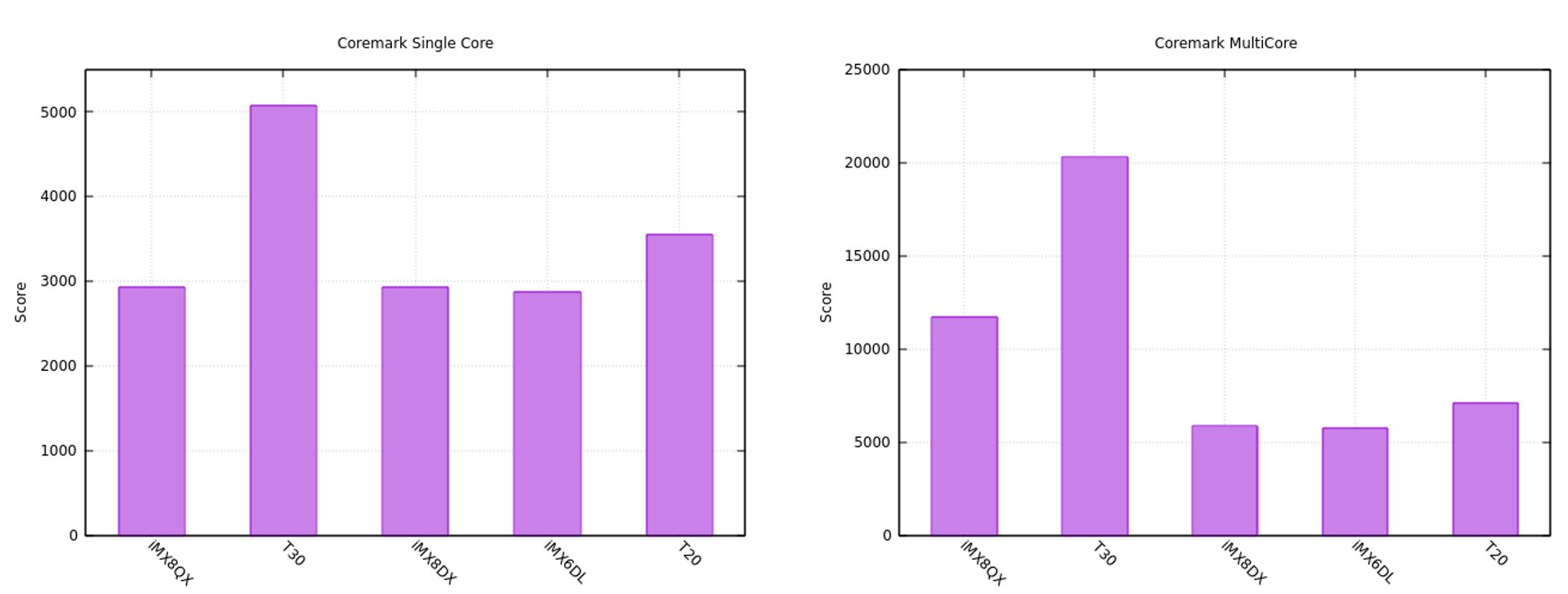
Memory Bandwith and Latency - Tinymemcbench
Tinymembench is a software made to test the system’s memory bandwidth and latency. Applications that rely on memory operations should benefit from faster memory.
Use cases:
- The kernel performs memory operations all the time
- Networking relies on memory
- Multimedia processing will benefit from faster memory
- User applications that make use of large buffers
The 64-bit processors have a potential for better latency on big buffers, not displayed in the results. For latency, lower is better.
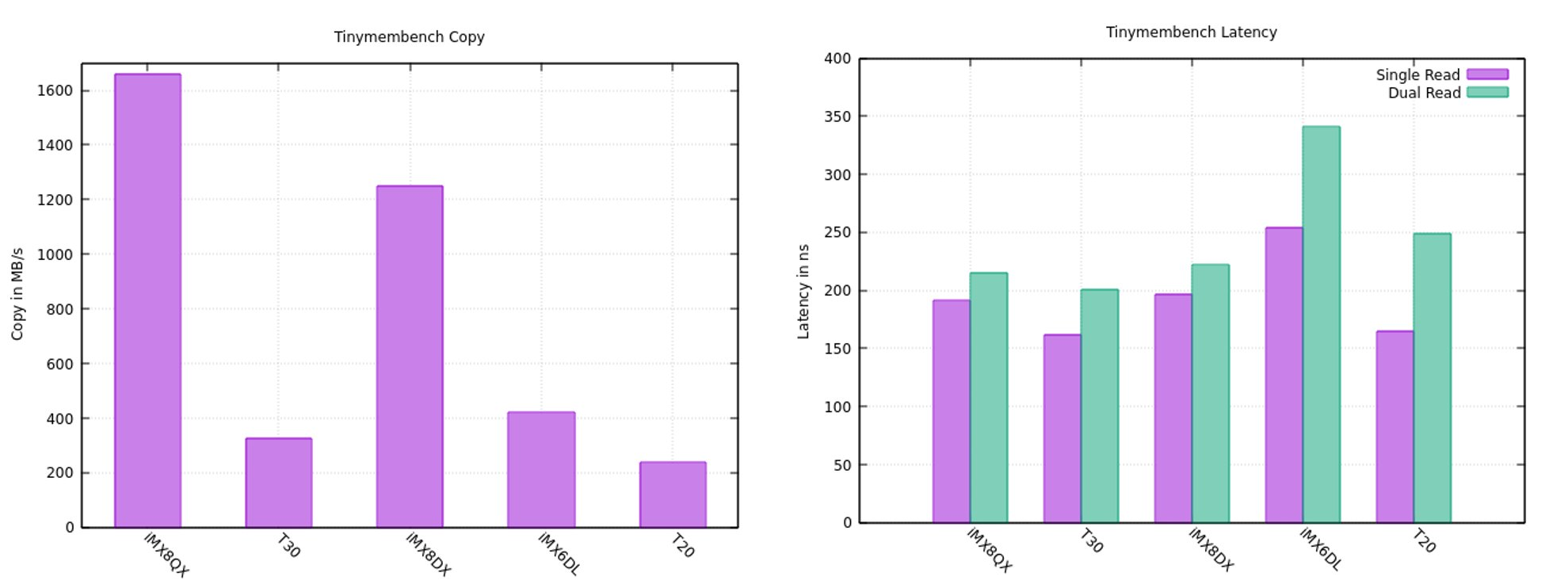
CPU & Memory - 7zip
The popular 7zip compression utility has a benchmarking mode that can use multiple threads and gives results that are heavily dependent on CPU integer and memory performance (especially latency). The benchmark score can also suffer if the system is low on free RAM.
This benchmark gives an idea of how well the processor performs with all its cores occupied and relies heavily on memory operations as well. The benchmark allocates big buffers and can easily fill in the entire memory that’s available on the system.
Use cases:
- Applications that need to deal with processing buffers fast (audio, video and network processing)
- Data logging and processing
- Compression
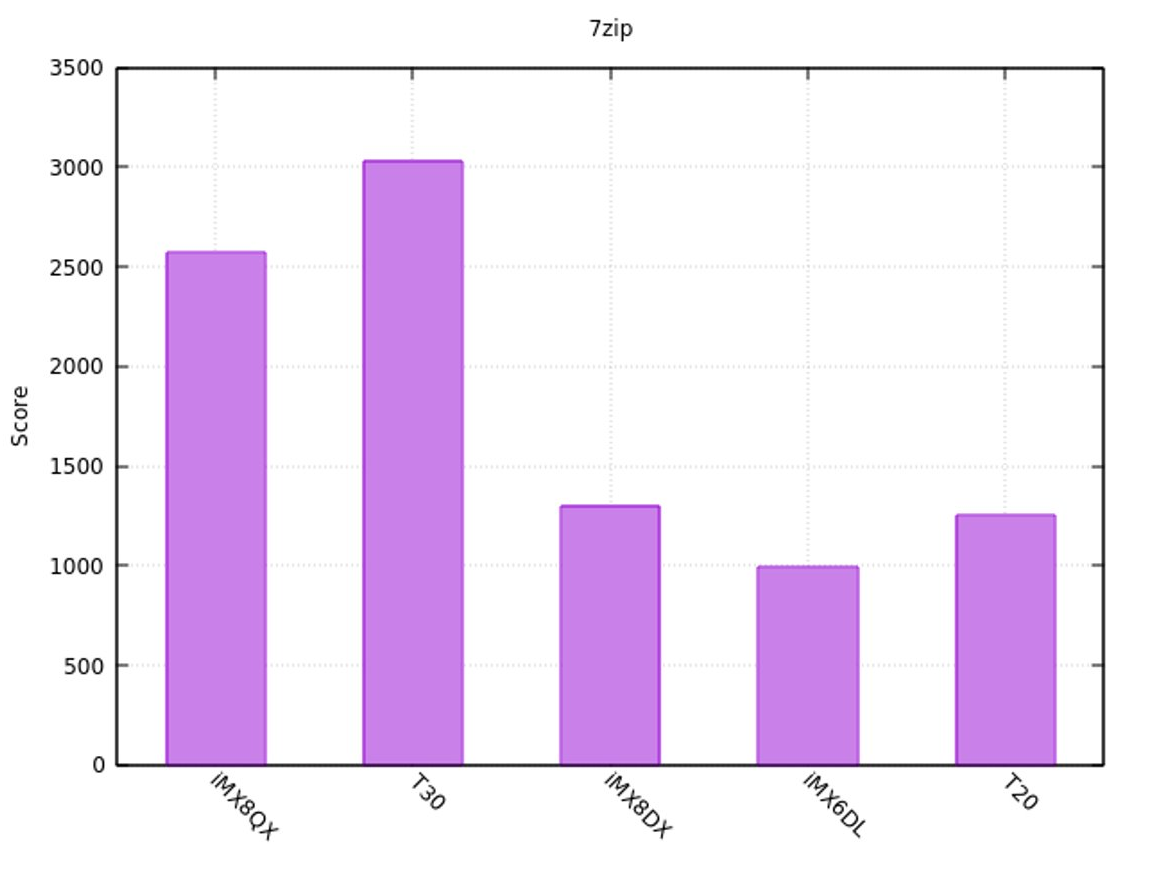
CPU & Memory - Stockfish
This is a popular open-source test engine. It is heavy on memory and puts a high load on the CPU. The engine scales very well with the number of cores available and is a good way to stress all the cores for a long time. It needs to be considered as more of an edge case as there are not many scenarios that are similar to this kind of test.
Use cases:
- Audio processing
- Number crunching (both integer and floating)
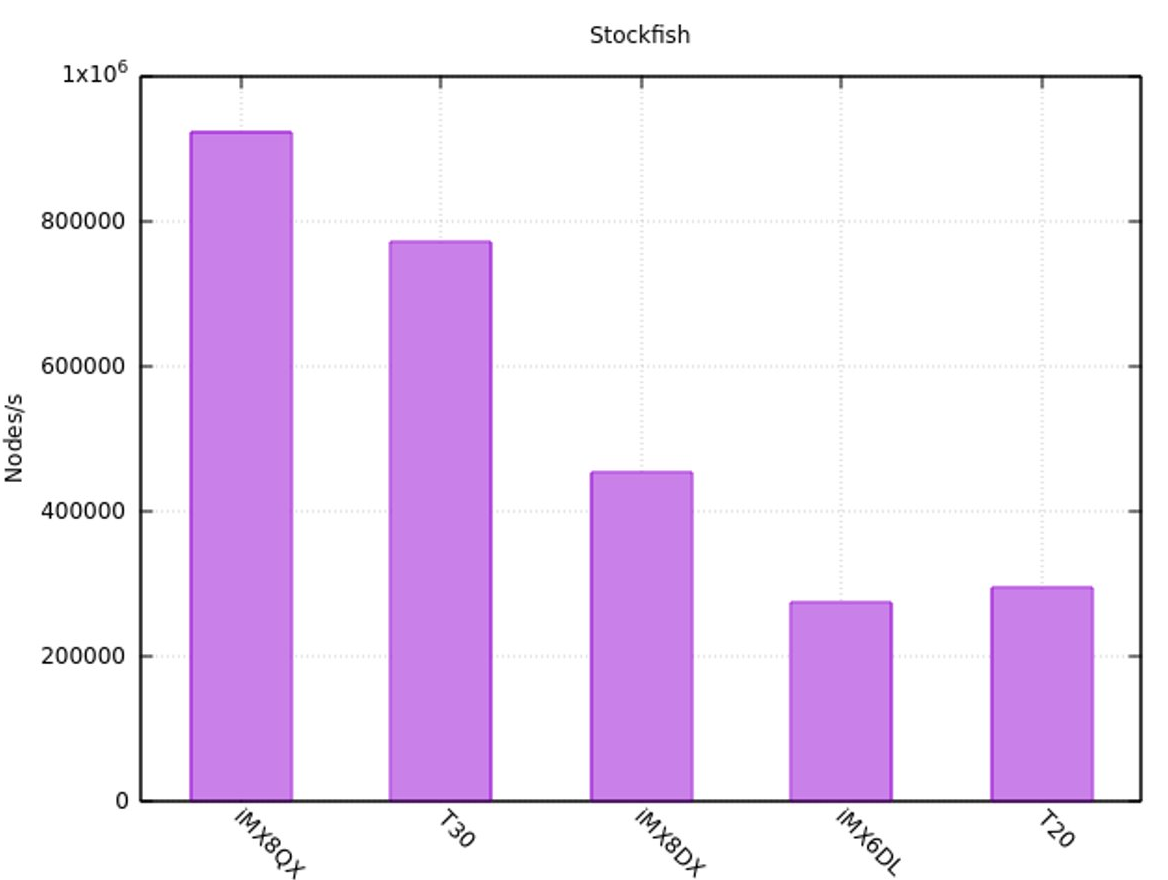
Flash Storage - Fio
Fio is a software made to test the performance of disk I/O devices, in this context, it will be used to test the flash storage of the SoMs. It is configurable to run several types of workloads. We used two different classes of block sizes.
- Small block sizes tend to be a more close measure of the raw I/O throughput of the flash memory
- Big block sizes make more use of the filesystem cache and are also influenced by RAM performance
Use cases:
- Data logging applications
- Applications that rely on reading/writing files
Higher flash storage performance can correlate to faster boot times and application loading times.
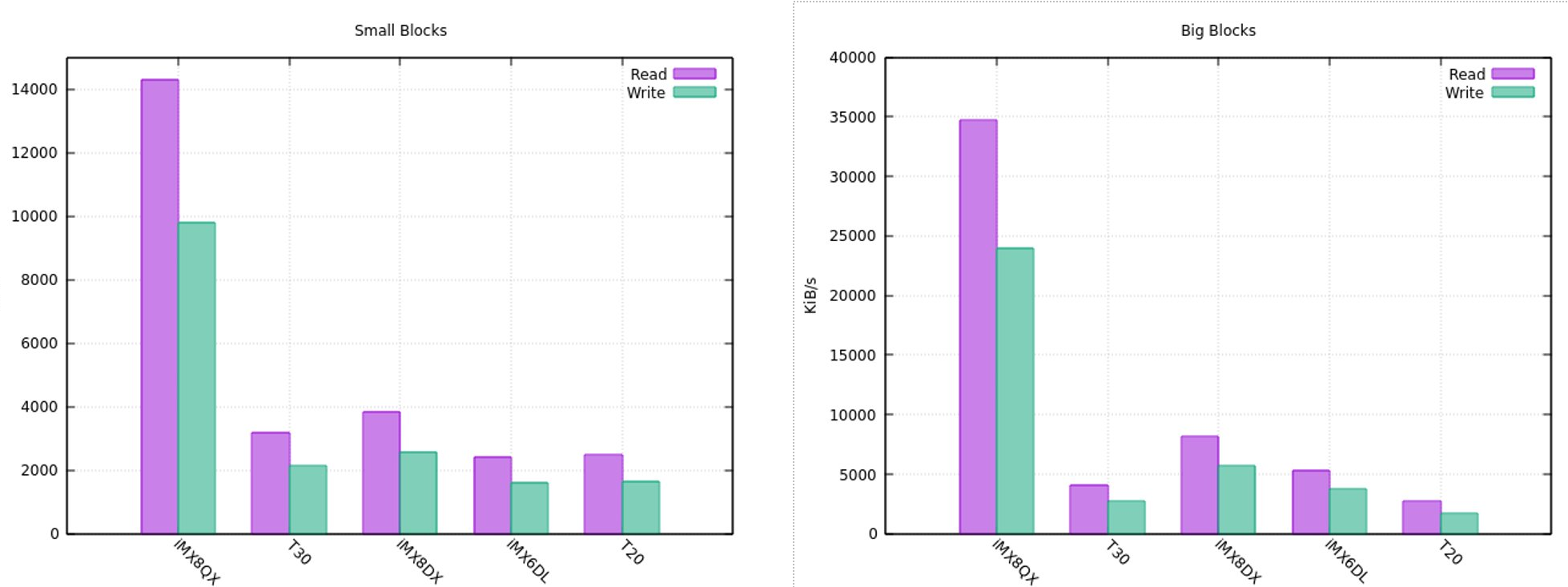
Check for Hardware Compatibility
To ensure hardware compatibility of our recommended SoMs with your custom needs, you should check the product pages and datasheets for detailed information.
Additionally, we have a tool that can help you check hardware compatibility of our recommended solutions and your product requirements. You can use the Toradex Pinout Design Tool to verify if the resources provided in the SoM recommendations are available for your particular needs.
You can learn how to use it on our Instruction Page.
It will help you to:
Hardware Design Update
Toradex provides resources to help the carrier board design:
- A complete Carrier Board Design Guide
- A great collection of Reference Designs and 3D Models
- A Partner Network you can contact for design and manufacturing
Need Help?
If you need help updating your hardware design, we have a great Partner Network. They can help you with Carrier Board Design, Production, and configuration of your Operating System to your custom hardware needs.
Contact Us so we can connect you with a suitable partner.